Dublin: Difference between revisions
Created page with '{{Infobox town |name=Dublin |irish=Baile Átha Cliath |county=County Dublin |picture=Dublin_lead_image.jpg |picture caption=Custom House, O'Connell Street, Temple Bar, Phoenix Pa…' |
No edit summary |
||
| (6 intermediate revisions by 4 users not shown) | |||
| Line 3: | Line 3: | ||
|irish=Baile Átha Cliath | |irish=Baile Átha Cliath | ||
|county=County Dublin | |county=County Dublin | ||
|picture= | |picture=O'Connell Bridge (25748548914).jpg | ||
|picture caption= | |picture caption=O'Connell Bridge, Dublin | ||
|LG district =Dublin | |LG district =Dublin | ||
|population =506,211 | |population =506,211 | ||
| Line 52: | Line 52: | ||
The Dublin Corporation governed the city from the Middle Ages. This represented the city's guild-based oligarchy until it was reformed in the 1840s on increasingly democratic lines. In 1348, the city was hit by the Black Death,<ref>"''[http://books.google.com/books?id=R688at3KskQC&pg=PA49&dq&hl=en#v=onepage&q=&f=false The Story of Ireland]''". Brian Igoe (2009). p.49.</ref> a lethal plague that ravaged Europe in the mid-14th century.<ref>"''[http://books.google.com/books?id=yw3HmjRvVQMC&pg=PA58&dq&hl=en#v=onepage&q=&f=false Black Death]''". Joseph Patrick Byrne (2004). p.58. ISBN 0313324921</ref> | The Dublin Corporation governed the city from the Middle Ages. This represented the city's guild-based oligarchy until it was reformed in the 1840s on increasingly democratic lines. In 1348, the city was hit by the Black Death,<ref>"''[http://books.google.com/books?id=R688at3KskQC&pg=PA49&dq&hl=en#v=onepage&q=&f=false The Story of Ireland]''". Brian Igoe (2009). p.49.</ref> a lethal plague that ravaged Europe in the mid-14th century.<ref>"''[http://books.google.com/books?id=yw3HmjRvVQMC&pg=PA58&dq&hl=en#v=onepage&q=&f=false Black Death]''". Joseph Patrick Byrne (2004). p.58. ISBN 0313324921</ref> | ||
From the 17th century the city expanded rapidly, helped by the Wide Streets Commission. The population grew from about 10,000 in 1600 to over 50,000 in 1700, and this in spite of another plague epidemic in 1649-51.<ref>"''[http://books.google.com/books?id=gI8MYY6ASdcC&pg=PA34&dq&hl=en#v=onepage&q=&f=false Dublin: a cultural history]''". Siobhán Marie Kilfeather (2005). Oxford University Press US. pp. 34-35. ISBN 0195182014</ref> Georgian Dublin was, for a short time, the second city of the British Empire after London and the fifth largest European city. Much of Dublin's most notable architecture dates from this time. In 1759, the founding of the Guinness brewery at St | From the 17th century the city expanded rapidly, helped by the Wide Streets Commission. The population grew from about 10,000 in 1600 to over 50,000 in 1700, and this in spite of another plague epidemic in 1649-51.<ref>"''[http://books.google.com/books?id=gI8MYY6ASdcC&pg=PA34&dq&hl=en#v=onepage&q=&f=false Dublin: a cultural history]''". Siobhán Marie Kilfeather (2005). Oxford University Press US. pp. 34-35. ISBN 0195182014</ref> Georgian Dublin was, for a short time, the second city of the British Empire after London and the fifth largest European city. Much of Dublin's most notable architecture dates from this time. In 1759, the founding of the Guinness brewery at St James's Gate resulted in a considerable economic impact for the city. For much of the time since its foundation, the Guinness brewery was the largest employer in the city but Roman Catholics were confined to the lower echelons of employment at Guinness and only entered management level in the 1960s. After Irish independence the Guinness Corporate headquarters were moved to London in the 1930s to avoid Irish taxation and a rival brewery to Dublin was opened in London at Park Royal to supply the United Kingdom. In 1742 Handel's "Messiah" was performed for the first time in New Musick Hall in Fishamble Street with 26 boys and five men from the combined choirs of St Patrick's and Christ Church cathedrals participating. | ||
After the Act of Union, 1800, with the seat of government moving to [[Westminster]], Dublin entered a period of decline, but still remained the centre of administration and a transport hub for much of Ireland. Dublin played no major role in the Industrial Revolution of the eighteenth and nineteenth centuries: Ireland had no native source of coal, the fuel of the time, and Dublin was not a centre of ship manufacture, the other main driver of industrial development in Britain and Ireland.<ref name="Davies"/> [[Belfast]] developed much faster than Dublin during this period on a mixture of international trade, factory-based linen cloth production and shipbuilding.<ref name="Lyons">{{cite book | last =Lyons | first =F.S.L. | authorlink =F.S.L. Lyons | title =Ireland since the famine | publisher =Collins / Fontana | year =1973 | location =Suffolk | isbn =0-00-633200-5 | page =880}}</ref> | After the Act of Union, 1800, with the seat of government moving to [[Westminster]], Dublin entered a period of decline, but still remained the centre of administration and a transport hub for much of Ireland. Dublin played no major role in the Industrial Revolution of the eighteenth and nineteenth centuries: Ireland had no native source of coal, the fuel of the time, and Dublin was not a centre of ship manufacture, the other main driver of industrial development in Britain and Ireland.<ref name="Davies"/> [[Belfast]] developed much faster than Dublin during this period on a mixture of international trade, factory-based linen cloth production and shipbuilding.<ref name="Lyons">{{cite book | last =Lyons | first =F.S.L. | authorlink =F.S.L. Lyons | title =Ireland since the famine | publisher =Collins / Fontana | year =1973 | location =Suffolk | isbn =0-00-633200-5 | page =880}}</ref> | ||
| Line 96: | Line 96: | ||
===Phoenix Parks=== | ===Phoenix Parks=== | ||
There are many park areas around the city, with the Phoenix Park, St Anne's Park and St Stephen's Green being the most popular. The Phoenix Park is | There are many park areas around the city, with the Phoenix Park, St Anne's Park and St Stephen's Green being the most popular. The Phoenix Park is two miles west of the city centre, north of the [[River Liffey]]. Its 10-mile perimeter wall encloses 1,750 acres; the largest walled city park in the British Isles,<ref> | ||
{{cite web | {{cite web | ||
|url=http://www.phoenixpark.ie/about/ | |url=http://www.phoenixpark.ie/about/ | ||
| Line 102: | Line 102: | ||
|publisher=Office of Public Works | |publisher=Office of Public Works | ||
|accessdate=2 January 2010 | |accessdate=2 January 2010 | ||
}}</ref><ref> after Richmond Park in [[Surrey]], (2,360 acres) though the latter is perhaps not a city park as Phoenix Park is.</ref> The name comes from the Irish ''fionn uisce'' meaning "clear water". It includes large areas of grassland and tree-lined avenues, and since the seventeenth century has been home to a herd of wild fallow deer. The residence of the President of Ireland (Áras an Uachtaráin), which was built in 1754, is located in the park. The park is also home to Dublin Zoo, the official residence of the United States Ambassador, and Ashtown Castle. Music concerts have been performed in the park by big name acts. | }}</ref><ref>after Richmond Park in [[Surrey]], (2,360 acres) though the latter is perhaps not a city park as Phoenix Park is.</ref> The name comes from the Irish ''fionn uisce'' meaning "clear water". It includes large areas of grassland and tree-lined avenues, and since the seventeenth century has been home to a herd of wild fallow deer. The residence of the President of Ireland (Áras an Uachtaráin), which was built in 1754, is located in the park. The park is also home to Dublin Zoo, the official residence of the United States Ambassador, and Ashtown Castle. Music concerts have been performed in the park by big name acts. | ||
===St Stephen’s Green=== | ===St Stephen’s Green=== | ||
| Line 125: | Line 125: | ||
===Dublin City University=== | ===Dublin City University=== | ||
Dublin City University (DCU) specialises in business, engineering, and science courses, particularly with relevance to industry. It has around 10,000 students, and is located about | Dublin City University (DCU) specialises in business, engineering, and science courses, particularly with relevance to industry. It has around 10,000 students, and is located about five miles north of the city. | ||
===Other institutions=== | ===Other institutions=== | ||
The Royal College of Surgeons in Ireland (the RCSI) is a medical school which is a recognised college of the NUI, it is situated at St | The Royal College of Surgeons in Ireland (the RCSI) is a medical school which is a recognised college of the NUI, it is situated at St Stephen's Green in the city centre. The National University of Ireland, Maynooth, another constituent university of the NUI, is in neighbouring [[County Kildare]]. The Institute of European Affairs is also in Dublin. Dublin Institute of Technology (DIT) is a modern technical college and is the country's largest non-university third-level institution. It specialises in technical subjects but also offers many arts and humanities courses. It is soon to be relocated to a new campus at [[Grangegorman]]. Two suburbs of Dublin, [[Tallaght]] and [[Blanchardstown]] have Institutes of Technology: Institute of Technology, Tallaght, and Institute of Technology, Blanchardstown. Portobello College has its degrees conferred through the University of Wales.<ref>{{cite web|url=http://www.portobello.ie/about_us/portobello_college.htm |title=Portobello College Dublin |publisher=Portobello.ie |date=|accessdate=2009-06-23}}</ref> Dublin Business School (DBS) is Ireland's largest private third level institution with over 9,000 students. The college is located on Aungier Street. The National College of Art and Design (NCAD) and Dun Laoghaire Institute of Art, Design and Technology (DLIADT) support training and research in art, design and media technology. The National College of Ireland (NCI) is also based in Dublin. The Economic and Social Research Institute, a social science research institute, is based on Sir John Rogerson's Quay, Dublin 2. | ||
The Irish public administration and management training centre has its base in Dublin, the Institute of Public Administration provides a range of undergraduate and post graduate awards via the National University of Ireland and in some instances, Queen's University Belfast. There are also smaller specialised colleges, including Griffith College Dublin, The Gaiety School of Acting and the New Media Technology College. | The Irish public administration and management training centre has its base in Dublin, the Institute of Public Administration provides a range of undergraduate and post graduate awards via the National University of Ireland and in some instances, Queen's University Belfast. There are also smaller specialised colleges, including Griffith College Dublin, The Gaiety School of Acting and the New Media Technology College. | ||
| Line 148: | Line 148: | ||
[[File:KellsFol032vChristEnthroned.jpg|thumb|upright|Book of Kells]] | [[File:KellsFol032vChristEnthroned.jpg|thumb|upright|Book of Kells]] | ||
Dublin is also the focal point for much of Irish Art and the Irish artistic scene. The Book of Kells, a world-famous manuscript produced by Celtic Monks around the year 800 and an example of Insular art, is on display in Trinity College. The Chester Beatty Library houses the famous collection of manuscripts, miniature paintings, prints, drawings, rare books and decorative arts assembled by American mining millionaire (and honorary Irish citizen) Sir Alfred Chester Beatty (1875–1968). The collections date from 2700 B.C. onwards and are drawn from Asia, the Middle East, North Africa and Europe. Work by local artists is often put on public display around St | Dublin is also the focal point for much of Irish Art and the Irish artistic scene. The Book of Kells, a world-famous manuscript produced by Celtic Monks around the year 800 and an example of Insular art, is on display in Trinity College. The Chester Beatty Library houses the famous collection of manuscripts, miniature paintings, prints, drawings, rare books and decorative arts assembled by American mining millionaire (and honorary Irish citizen) Sir Alfred Chester Beatty (1875–1968). The collections date from 2700 B.C. onwards and are drawn from Asia, the Middle East, North Africa and Europe. Work by local artists is often put on public display around St Stephen's Green, the main public park in the city centre. In addition large art galleries are found across the city, including the Irish Museum of Modern Art, the National Gallery, the Hugh Lane Municipal Gallery, The City Arts Centre, The Douglas Hyde Gallery, The Project Arts Centre and The Royal Hibernian Academy. Three branches of the National Museum of Ireland are located in Dublin: Archaeology in Kildare Street, Decorative Arts and History in Collins Barracks and Natural History in Merrion Street.<ref>{{cite web|url=http://www.museum.ie/en/homepage.aspx |title=National Museum of Ireland |publisher=Museum.ie |date=2010-06-08 |accessdate=2010-06-17}}</ref> | ||
===Music, opera and drama=== | ===Music, opera and drama=== | ||
Dublin is home to many acclaimed dramatic, musical and operatic companies, including: Festival Productions, Lyric Opera Productions, The Pioneers Musical & Dramatic Society, The Glasnevin Musical Society, Second Age Theatre Company, Opera Theatre Company, Opera Ireland among others. Ireland is well known for its love of baroque music, which is highly acclaimed at Trinity College.<ref>{{cite web |url=http://tcdlocalportal.tcd.ie/pls/public/staff.detail?p_unit=music&p_name=johnstoa |title=Baroque Music in Dublin, Ireland}}</ref> | Dublin is home to many acclaimed dramatic, musical and operatic companies, including: Festival Productions, Lyric Opera Productions, The Pioneers Musical & Dramatic Society, The Glasnevin Musical Society, Second Age Theatre Company, Opera Theatre Company, Opera Ireland among others. Ireland is well known for its love of baroque music, which is highly acclaimed at Trinity College.<ref>{{cite web |url=http://tcdlocalportal.tcd.ie/pls/public/staff.detail?p_unit=music&p_name=johnstoa |title=Baroque Music in Dublin, Ireland}}</ref> | ||
Perhaps the most famous Dublin theatre company is the hugely renowned Rathmines and Rathgar Musical Society which has been in existence since 1913. The company has long produced full scale productions of popular musicals and operettas. | Perhaps the most famous Dublin theatre company is the hugely renowned Rathmines and Rathgar Musical Society which has been in existence since 1913. The company has long produced full-scale productions of popular musicals and operettas. | ||
===Entertainment=== | ===Entertainment=== | ||
| Line 181: | Line 181: | ||
*[http://www.transportfordublin.ie/ Transport for Dublin ] - public transport website | *[http://www.transportfordublin.ie/ Transport for Dublin ] - public transport website | ||
*[http://www.flickr.com/photos/41182695@N08/sets/72157622745270034/ Dublin photo gallery] A free photo gallery of Dublin and its most popular monuments | *[http://www.flickr.com/photos/41182695@N08/sets/72157622745270034/ Dublin photo gallery] A free photo gallery of Dublin and its most popular monuments | ||
[[Category:Ports of County Dublin]] | |||
{{Cities in the Republic of Ireland}} | |||
Latest revision as of 22:32, 7 February 2023
| Dublin Irish: Baile Átha Cliath | |
| County Dublin | |
|---|---|
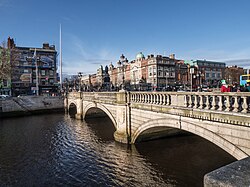 O'Connell Bridge, Dublin | |
| Location | |
| Grid reference: | O159341 |
| Location: | 53°20’37"N, 6°14’58"W |
| Data | |
| Population: | 506,211 |
| Postcode: | D1-18, 20, 22, 24, D6W |
| Dialling code: | 01 |
| Local Government | |
| Council: | Dublin |
Dublin is the county town of County Dublin and the capital city of the Republic of Ireland. It stands on the River Liffey as that river enters the sea near the midpoint of Ireland's east coast and the midst of County Dublin's coast. Dublin is the biggest city in the Irish Republic and its commercial, cultural, intellectual and political centre. It has served as the capital of Ireland since the days of King Henry II, and before then as the heart of the Norse Kingdom of Dublin, leaving the city with a vast historical heritage.
Today, Dublin is ranked 23rd in the Global Financial Centres Index.[1][2]
Name of the city
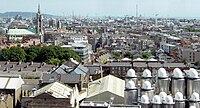
The name of Dublin is derived from the Irish words Dubh Linn, meaning "black pool" (coincidentally also the name of the Lancaster city which faces it across the sea).
The common name used for the city in modern Irish is Baile Átha Cliath (meaning "town of the hurdled ford"). Áth Cliath is a place-name referring to a fording point of the Liffey in the vicinity of Heuston Station. Baile Átha Cliath was an early Christian monastery which is believed to have been situated in the area of Aungier Street currently occupied by the Whitefriar Street Carmelite Church.
In earlier centuries the Greek geographer Ptolomey essayed a map showing a place he named "Eblana" on Ireland's east coast, which is often taken to be Dublin, though from long before the city was founded.
Dublin itself was founded by Scandinavian invaders, who took the Irish "black pool" and called their town Dyfelin or Dyfelinnin (which is the modern Icelandic name for Dublin). In Irish, Dubh is correctly pronounced as Duv or Duf. An early reference to Dublin in English is in the poem The Battle of Brunanburh which says the fleeing Norse took to their ships seeking Difelin. Historically, Gaelic was written with a dot over the b in place of today's bh, which might explain today's English spelling.
The Norse settlement was on the River Poddle, a tributary of the Liffey, to the east of where Christ Church Cathedral now stands, in an area now known as Wood Quay. The Dubh Linn was a lake used to moor ships, connected to the Liffey by the Poddle. The Dubh Linn and Poddle were covered during the early 1700s, and as the city expanded they were largely forgotten about. The Dubh Linn lay where the Castle Garden is now located, opposite the Chester Beatty Library in Dublin Castle.
Táin Bó Cuailgne also known as The Cattle Raid of Cooley refers to Dublind rissa ratter Áth Cliath, meaning Dublin, which is called Ath Cliath.
Geography
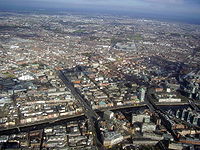
Location
Dublin stands at the mouth of the River Liffey, which cuts through the lowlands and flows into the Irish Sea. In the south, Dublin is bordered by a low mountain range. The surrounding counties to the north and west of Dublin are surrounded by flat farmland.[3]
Traditionally, a north versus south division has existed in Dublin with the dividing line provided by the River Liffey. The Northside is generally seen as working-class, while the Southside is seen as middle and upper middle class. The divide is punctuated by examples of Dublin "sub-culture" stereotypes, with upper-middle class constituents seen as tending towards an accent and demeanour synonymous with the Southside, and working-class Dubliners seen as tending towards accents and demeanour associated with Northside and inner-city Dublin neighbourhoods. The economic divide in Dublin is east-west as well as north-south. There are also social divisions evident between the coastal suburbs in the east of the city, including those on the northside, and the newer developments further to the west.[4]
History
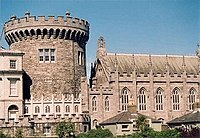
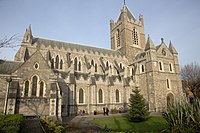
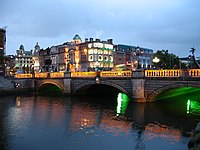
The writings of the Greek astronomer and cartographer Ptolemy provide perhaps the earliest reference to human habitation in the area now known as Dublin. In around A.D. 140 he referred to a settlement he called Eblana Civitas. The settlement 'Dubh Linn' dates perhaps as far back as the first century BC and later a monastery was built there, though the town was established in about 841[5] by the Norse. The modern city retains the Anglicised Irish name of the former and the original Irish name of the latter.
Norsement descended upon Ireland in the Dark Ages and founded Dublin as a town, consolidated as the centre of the Kingdom of Dublin from about 840. Their settlement was on the River Poddle, a tributary of the Liffey, to the east of Christ Church Cathedral, in an area now known as Wood Quay. The Dubh Linn was a lake used by the Scandinavians to moor their ships and was connected to the Liffey by the Poddle. The Dubh Linn and Poddle were covered during the early 1700s, and as the city expanded they were largely forgotten about. The Dubh Linn was situated where the Castle Garden is now located, opposite the Chester Beatty Library in Dublin Castle.
Dublin was ruled by the Norse for most of the time form 841 until the coming of the English and Normans. In 999 Dublin was sacked by Brian Boru, the King of Munster.[6] Although Dublin still had a Norse king after the Battle of Clontarf in 1014, Norse influence waned under a growing Gaelic supremacy until the conquest of Ireland which was launched from Britain in 1169-1172.[6]
In 1171 the city was conquered by the Earl of Pembroke, known as "Strongbow" and the last Norse king, Hasculf Rognvaldsson, was expelled.
The Dublin Corporation governed the city from the Middle Ages. This represented the city's guild-based oligarchy until it was reformed in the 1840s on increasingly democratic lines. In 1348, the city was hit by the Black Death,[7] a lethal plague that ravaged Europe in the mid-14th century.[8]
From the 17th century the city expanded rapidly, helped by the Wide Streets Commission. The population grew from about 10,000 in 1600 to over 50,000 in 1700, and this in spite of another plague epidemic in 1649-51.[9] Georgian Dublin was, for a short time, the second city of the British Empire after London and the fifth largest European city. Much of Dublin's most notable architecture dates from this time. In 1759, the founding of the Guinness brewery at St James's Gate resulted in a considerable economic impact for the city. For much of the time since its foundation, the Guinness brewery was the largest employer in the city but Roman Catholics were confined to the lower echelons of employment at Guinness and only entered management level in the 1960s. After Irish independence the Guinness Corporate headquarters were moved to London in the 1930s to avoid Irish taxation and a rival brewery to Dublin was opened in London at Park Royal to supply the United Kingdom. In 1742 Handel's "Messiah" was performed for the first time in New Musick Hall in Fishamble Street with 26 boys and five men from the combined choirs of St Patrick's and Christ Church cathedrals participating.
After the Act of Union, 1800, with the seat of government moving to Westminster, Dublin entered a period of decline, but still remained the centre of administration and a transport hub for much of Ireland. Dublin played no major role in the Industrial Revolution of the eighteenth and nineteenth centuries: Ireland had no native source of coal, the fuel of the time, and Dublin was not a centre of ship manufacture, the other main driver of industrial development in Britain and Ireland.[6] Belfast developed much faster than Dublin during this period on a mixture of international trade, factory-based linen cloth production and shipbuilding.[10]
The Easter Rising of 1916, the War of Independence (Anglo-Irish War), and Irish Civil War resulted in a significant amount of physical destruction in the city centre. The Irish Free State government rebuilt the city centre and located the Dáil (parliament) in Leinster House.
Since 1997, the landscape of Dublin has changed immensely, with enormous private sector and state development of housing, transport, and business. Some well-known Dublin street corners are still named for the pub or business which used to occupy the site before closure or redevelopment.
Since the beginning of Anglo-Norman rule in the 12th century, the city has functioned as the capital in varying geopolitical entities: Lordship of Ireland (1171–1541), Kingdom of Ireland (1541–1800), island as part of the United Kingdom of Great Britain and Ireland (1801–1922). From 1922, following the partition of Ireland, it became the capital of the Irish Free State (1922–1949) and now is the capital of the Republic of Ireland. One of the memorials to commemorate that time is the Garden of Remembrance.
National government
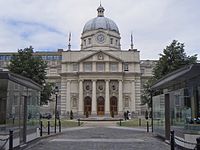
The national parliament of Ireland, the Oireachtas, consists of the President of Ireland and two houses, Dáil Éireann (House of Representatives) and Seanad Éireann (Senate). All three are based in Dublin. The President of Ireland lives in Áras an Uachtaráin, the former residence of the Governor-General of the Irish Free State in the city's largest park, Phoenix Park. Both houses of the Oireachtas meet in Leinster House, a former ducal palace on the south side. The building has been the home of Irish parliaments since the creation of the Irish Free State. The old Irish Houses of Parliament of the Kingdom of Ireland are in College Green.
Government Buildings house the Department of the Taoiseach, the Council Chamber (used for the weekly Cabinet meetings), the Department of Finance and the Office of the Attorney General. It consists of a main building (completed 1911) with two wings (completed 1921) and was designed by Thomas Manley Dean and Sir Aston Webb as the Royal College of Science. In 1921 the House of Commons of Southern Ireland met here. Given its location next to Leinster House, the Irish Free State government took over the two wings of the building to serve as a temporary home for some ministries, while the central building became the College of Technology (part of University College Dublin) until 1989.[11] Both it and Leinster House, meant to be a temporary home of parliament, became permanent homes.
Cathedrals
The Church of Ireland as two cathedrals in Dublin:
- Christ Church Cathedral - The earliest manuscript dates Christ Church cathedral to around 1030, founded by Dúnán the first bishop of Dublin and Sihtric, King of Dublin.
- St Patrick's Cathedral – established in 1191 by Archbishop John Comyn, though the present building was erected between 1200 and 1270.
Sights of the City
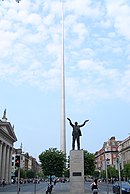
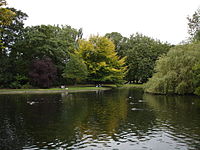
Dublin has many landmarks and monuments dating back hundreds of years. One of the oldest is Dublin Castle, which was first founded as a major defensive work on the orders of King John of England in 1204, shortly after the Norman invasion of Ireland in 1169, when it was commanded that a castle be built with strong walls and good ditches for the defence of the city, the administration of justice, and the protection of the King's treasure.[12] Largely complete by 1230, the castle was of typical Norman courtyard design, with a central square without a keep, bounded on all sides by tall defensive walls and protected at each corner by a circular tower. Sited to the south-east of Norman Dublin, the castle formed one corner of the outer perimeter of the city, using the River Poddle as a natural means of defence.
One of Dublin's newest monuments is the Spire of Dublin, or officially titled the "Monument of Light",[13] but more demotically known as “the Stiletto in the Ghetto” or “the Nail in the Pale”. It is a 398-foot conical spire made of stainless steel standing on O'Connell Street in the centre of Dublin, on the north side. It replaces Nelson's Pillar, which stood on the same location, and it is intended to mark Dublin's place in the 21st Century. The spire was designed by Ian Ritchie Architects,[14] who sought an "Elegant and dynamic simplicity bridging art and technology". During the day it maintains its steel look, but at dusk the monument appears to merge into the sky. The base of the monument is lit and the top is illuminated to provide a beacon in the night sky across the city.
Two more pieces of civic sculpture funded by European money and given humorous local nicknames are the Anna Livia monument (“the Floozy in the Jacuzzi”), and the Molly Malone statue (“the Tart with the Cart”)
Other popular landmarks and monuments include the Mansion House, and Áras an Uachtaráin (the President’s residence in Phoenix Park).
Phoenix Parks
There are many park areas around the city, with the Phoenix Park, St Anne's Park and St Stephen's Green being the most popular. The Phoenix Park is two miles west of the city centre, north of the River Liffey. Its 10-mile perimeter wall encloses 1,750 acres; the largest walled city park in the British Isles,[15][16] The name comes from the Irish fionn uisce meaning "clear water". It includes large areas of grassland and tree-lined avenues, and since the seventeenth century has been home to a herd of wild fallow deer. The residence of the President of Ireland (Áras an Uachtaráin), which was built in 1754, is located in the park. The park is also home to Dublin Zoo, the official residence of the United States Ambassador, and Ashtown Castle. Music concerts have been performed in the park by big name acts.
St Stephen’s Green
St Stephen's Green is adjacent to one of Dublin's main shopping streets, Grafton Street, and to a shopping centre named for it, while on its surrounding streets are the offices of a number of public bodies and the city terminus of one of Dublin's Luas tram lines.
St Anne's Park
St Anne's Park is a public park and recreational facility, shared between Raheny and Clontarf, both suburbs on the North Side of Dublin. The park, the second largest municipal park in Dublin, is part of a former 500 acre estate assembled by members of the Guinness family, beginning with Benjamin Lee Guinness in 1835 (the largest municipal park is nearby (North) Bull Island, also shared between Clontarf and Raheny). Features include an artificial pond and a number of follies.
Economy
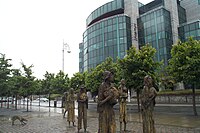
Dublin has been at the centre of Ireland's phenomenal economic growth and subsequent economic contraction over the last decade, a period (often of double-digit growth) referred to as the Celtic Tiger years. In 2009, Dublin was listed as the fourth-richest city in the world.[17] According to one source, Dublin is now the world's 25th most expensive city.[18] It is also listed as the tenth most expensive city in the world in which to live.[19] However, it had the second highest wages for a city in the world, ahead of both New York City and London, though behind Zürich but as of 2009 has dropped to tenth highest.[20] In 2005, around 800,000 people were employed in the Greater Dublin Area, of whom around 600,000 were employed in the services sector and 200,000 in the industrial sector.[21]
Universities

Dublin has three universities and many other higher education institutions. There are 20 third-level institutes in the city.
Trinity College
The University of Dublin is the oldest university in Ireland dating from the 16th century, and is located in the city centre. Its sole constituent college, Trinity College, was established by Royal Charter in 1592 under Queen Elizabeth I. It was closed to Roman Catholics until Roman Catholic Emancipation; the Roman Catholic Church hierarchy then banned Roman Catholics from attending it until 1970. It is situated in the city centre, on College Green, and has 15,000 students.
National University of Ireland
The National University of Ireland (NUI) has its seat in Dublin, which is also the location of the associated constituent university of University College Dublin (UCD), the largest university in Ireland with over 22,000 students. UCD's main campus at Belfield is located about three miles south-east of the city centre.
Dublin City University
Dublin City University (DCU) specialises in business, engineering, and science courses, particularly with relevance to industry. It has around 10,000 students, and is located about five miles north of the city.
Other institutions
The Royal College of Surgeons in Ireland (the RCSI) is a medical school which is a recognised college of the NUI, it is situated at St Stephen's Green in the city centre. The National University of Ireland, Maynooth, another constituent university of the NUI, is in neighbouring County Kildare. The Institute of European Affairs is also in Dublin. Dublin Institute of Technology (DIT) is a modern technical college and is the country's largest non-university third-level institution. It specialises in technical subjects but also offers many arts and humanities courses. It is soon to be relocated to a new campus at Grangegorman. Two suburbs of Dublin, Tallaght and Blanchardstown have Institutes of Technology: Institute of Technology, Tallaght, and Institute of Technology, Blanchardstown. Portobello College has its degrees conferred through the University of Wales.[22] Dublin Business School (DBS) is Ireland's largest private third level institution with over 9,000 students. The college is located on Aungier Street. The National College of Art and Design (NCAD) and Dun Laoghaire Institute of Art, Design and Technology (DLIADT) support training and research in art, design and media technology. The National College of Ireland (NCI) is also based in Dublin. The Economic and Social Research Institute, a social science research institute, is based on Sir John Rogerson's Quay, Dublin 2.
The Irish public administration and management training centre has its base in Dublin, the Institute of Public Administration provides a range of undergraduate and post graduate awards via the National University of Ireland and in some instances, Queen's University Belfast. There are also smaller specialised colleges, including Griffith College Dublin, The Gaiety School of Acting and the New Media Technology College.

Culture
Literature, theatre and art
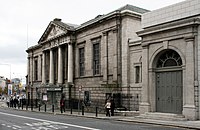
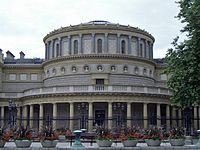
The city has a world-famous literary history, having produced many prominent literary figures, including Nobel laureates William Butler Yeats, George Bernard Shaw and Samuel Beckett. Other influential writers and playwrights from Dublin include Oscar Wilde, Jonathan Swift and the creator of Dracula, Bram Stoker.
Dublin serves as an epic stage for one of the greatest works of James Joyce: Ulysses. Dubliners is a collection of short stories by Joyce about incidents and characters typical of residents of the city in the early part of the 20th century.
Additional widely celebrated writers from the city include J M Synge, Seán O'Casey, Brendan Behan, Maeve Binchy, and Roddy Doyle. Ireland's biggest libraries and literary museums are found in Dublin, including the National Print Museum of Ireland and National Library of Ireland. In July 2010, Dublin was named as a UNESCO City of Literature, joining Edinburgh, Melbourne and Iowa City with the permanent title.[23]
There are several theatres within the city centre, and various world famous actors have emerged from the Dublin theatrical scene. The best known theatres include the Gaiety, the Abbey, the Olympia and the Gate. The Gaiety Theatre specialises in musical and operatic productions, and is popular for opening its doors after the evening theatre production to host a variety of live music, dancing, and films. The Abbey Theatre was founded in 1904 by a group that included Yeats with the aim of promoting indigenous literary talent. It went on to provide a breakthrough for some of the city's most famous writers, such as Synge, Yeats himself and George Bernard Shaw. The Gate Theatre was founded in 1928 to promote European and American Avant Garde works. The largest theatre is the Grand Canal Theatre in the Dublin Docklands, which opened in 2010.
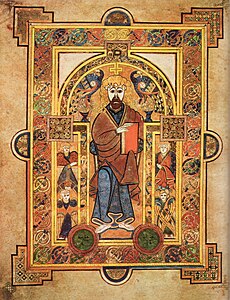
Dublin is also the focal point for much of Irish Art and the Irish artistic scene. The Book of Kells, a world-famous manuscript produced by Celtic Monks around the year 800 and an example of Insular art, is on display in Trinity College. The Chester Beatty Library houses the famous collection of manuscripts, miniature paintings, prints, drawings, rare books and decorative arts assembled by American mining millionaire (and honorary Irish citizen) Sir Alfred Chester Beatty (1875–1968). The collections date from 2700 B.C. onwards and are drawn from Asia, the Middle East, North Africa and Europe. Work by local artists is often put on public display around St Stephen's Green, the main public park in the city centre. In addition large art galleries are found across the city, including the Irish Museum of Modern Art, the National Gallery, the Hugh Lane Municipal Gallery, The City Arts Centre, The Douglas Hyde Gallery, The Project Arts Centre and The Royal Hibernian Academy. Three branches of the National Museum of Ireland are located in Dublin: Archaeology in Kildare Street, Decorative Arts and History in Collins Barracks and Natural History in Merrion Street.[24]
Music, opera and drama
Dublin is home to many acclaimed dramatic, musical and operatic companies, including: Festival Productions, Lyric Opera Productions, The Pioneers Musical & Dramatic Society, The Glasnevin Musical Society, Second Age Theatre Company, Opera Theatre Company, Opera Ireland among others. Ireland is well known for its love of baroque music, which is highly acclaimed at Trinity College.[25]
Perhaps the most famous Dublin theatre company is the hugely renowned Rathmines and Rathgar Musical Society which has been in existence since 1913. The company has long produced full-scale productions of popular musicals and operettas.
Entertainment
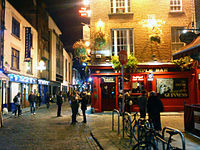
There is a vibrant nightlife in Dublin, which is reputedly one of the most youthful cities in Europe, with estimates of 50% of citizens being younger than 25. Like the rest of Ireland, there are pubs right across the city centre. The area around St Stephen's Green, especially Harcourt Street, Camden Street, Wexford Street and Leeson Street, is a centre for some of the most popular nightclubs and pubs in Dublin.
The internationally best-known area for nightlife is the Temple Bar area just south of the River Liffey. To some extent, the area has become a hot spot for tourists, including stag and hen parties from Britain.[26] It was developed as Dublin's cultural quarter (an idea proposed by local politician Charlie Haughey), and does retain this spirit as a centre for small arts productions, photographic and artists' studios, and in the form of street performers and intimate small music venues. It is regarded, in general, by locals as kitch with false "ye olde Irish" pretensions and best left to tourists. The areas around Leeson Street, Harcourt Street, South William Street and Camden/George's Street are popular nightlife spots for locals.
Live music is popularly played on streets and at venues throughout Dublin in general and the city has produced several musicians and groups of international success.
The two best known cinemas in the city centre are the Savoy Cinema and the Cineworld Cinema, both north of the Liffey. Alternative and special-interest cinema can be found in the Irish Film Institute in Temple Bar, in the Screen Cinema on d'Olier Street and in the Lighthouse Cinema in Smithfield. Across suburban Dublin are located large modern multiscreen cinemas. Situated on the Liffey at the Eastlink tollbridge, The O2, has played host to many world renowned performers.
References
- ↑ "GFCI5_3covers.qxd" (PDF). http://www.lefigaro.fr/assets/pdf/bourse-patrimoine/financial.pdf. Retrieved 2009-07-08.
- ↑ "GFCI4_4covers.qxd" (PDF). http://server-uk.imrworldwide.com/cgi-bin/b?cg=downloadsedo&ci=cityoflondon&tu=http://217.154.230.218/NR/rdonlyres/102CD2E5-FB72-4B9B-A30C-56FD592B5B61/0/BC_RS_GFCI4.pdf. Retrieved 2010-06-17.
- ↑ Dublin City Council - Facts About Dublin City
- ↑ Northside vs Southside
- ↑ "A Popular History of Ireland - Thomas D'Arcy McGee (1825-1868)". Nalanda.nitc.ac.in. http://www.nalanda.nitc.ac.in/resources/english/etext-project/history/ireland/book-2chapter2.html. Retrieved 2010-06-17.
- ↑ 6.0 6.1 6.2 Davies, Norman (1999). The Isles: a history. London: Macmillan. p. 1222. ISBN 0-333-76370.
- ↑ "The Story of Ireland". Brian Igoe (2009). p.49.
- ↑ "Black Death". Joseph Patrick Byrne (2004). p.58. ISBN 0313324921
- ↑ "Dublin: a cultural history". Siobhán Marie Kilfeather (2005). Oxford University Press US. pp. 34-35. ISBN 0195182014
- ↑ Lyons, F.S.L. (1973). Ireland since the famine. Suffolk: Collins / Fontana. p. 880. ISBN 0-00-633200-5.
- ↑ Department of the Taoiseach: Guide to Government Buildings (2005)
- ↑ McCarthy, Denis; Benton, David (2004). Dublin Castle: at the heart of Irish History. Dublin: Irish Government Stationary Office. pp. 12–18. ISBN 0-75571-9751.
- ↑ "Spire cleaners get prime view of city". Irish Independent. 5 June 2007. http://www.independent.ie/national-news/spire-cleaners-get-prime-view-of-city-691362.html. Retrieved 5 June 2007.
- ↑ "The Dublin Spire". Archiseek.com. http://www.irish-architecture.com/buildings_ireland/dublin/northcity/oconnell_street/spire.html. Retrieved 29 September 2008.
- ↑ "About – Phoenix Park". Office of Public Works. http://www.phoenixpark.ie/about/. Retrieved 2 January 2010.
- ↑ after Richmond Park in Surrey, (2,360 acres) though the latter is perhaps not a city park as Phoenix Park is.
- ↑ "''The world's richest cities by purchasing power in 2009''". City Mayors. http://www.citymayors.com/economics/usb-purchasing-power.html. Retrieved 2010-06-17.
- ↑ Global/Worldwide Cost of Living Survey Rankings 2007/2008, Cities, International, Europe 2007
- ↑ "''The world's most expensive cities in 2008''". City Mayors. 2009-08-22. http://www.citymayors.com/economics/expensive_cities2.html. Retrieved 2010-06-17.
- ↑ "London is the most expensive city in the world, while Swiss cities are home to highest earners". Citymayors.com. 2009-08-22. http://www.citymayors.com/economics/richest_cities.html. Retrieved 2010-06-17.
- ↑ Dublin employment (PDF
- ↑ "Portobello College Dublin". Portobello.ie. http://www.portobello.ie/about_us/portobello_college.htm. Retrieved 2009-06-23.
- ↑ Irish Independent - Delight at City of Literature accolade for Dublin Retrieved 26 July 2010.
- ↑ "National Museum of Ireland". Museum.ie. 2010-06-08. http://www.museum.ie/en/homepage.aspx. Retrieved 2010-06-17.
- ↑ "Baroque Music in Dublin, Ireland". http://tcdlocalportal.tcd.ie/pls/public/staff.detail?p_unit=music&p_name=johnstoa.
- ↑ Article on stag/hen parties in Edinburgh, Scotland (which mentions their popularity in Dublin), mentioning Dublin, Accessed Feb 15 2009.
Further reading
- John Flynn and Jerry Kelleher, Dublin Journeys in America (High Table Publishing, 2003) ISBN 0-9544694-1-0
- Hanne Hem, Dubliners, An Anthropologist's Account, Oslo, 1994
- Pat Liddy, Dublin A Celebration - From the 1st to the 21st century (Dublin City Council, 2000) ISBN 0-946841-50-0
- Maurice Craig, The Architecture of Ireland from the Earliest Times to 1880 (Batsford, Paperback edition 1989) ISBN 0-7134-2587-3
- Frank McDonald, Saving the City: How to Halt the Destruction of Dublin (Tomar Publishing, 1989) ISBN 1-871793-03-3
- Edward McParland, Public Architecture in Ireland 1680–1760 (Yale University Press, 2001) ISBN 0-300-09064-1
Outside links
- Dublin City Council - Official website of the local authority for Dublin
- Dublin Tourist Board - Official tourism site
- Transport for Dublin - public transport website
- Dublin photo gallery A free photo gallery of Dublin and its most popular monuments
| Cities in the Republic of Ireland |
|---|